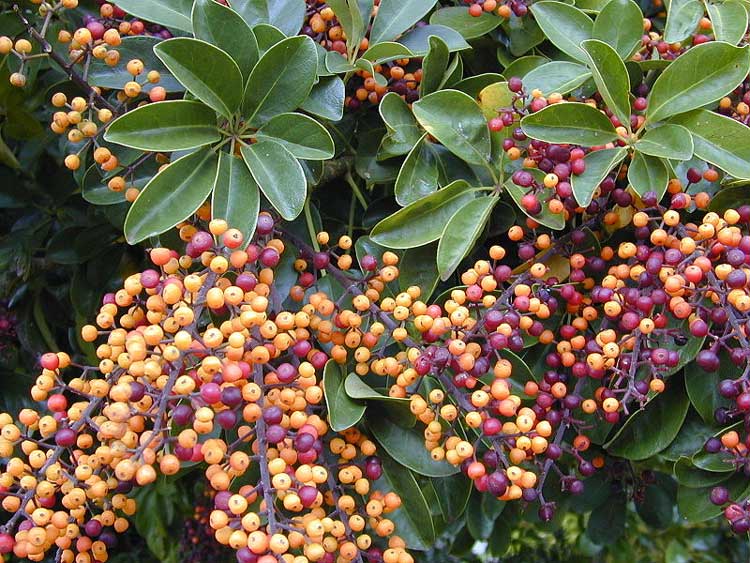
Heptapleurum arboricola (Photo: Forest & Kim Starr)
Classification System: APG IV
Superregnum: Eukaryota
Regnum: Plantae
Cladus: Angiosperms
Cladus: Eudicots
Cladus: Core eudicots
Cladus: Asterids
Cladus: Campanulids
Ordo: Apiales
Familia: Araliaceae
Subfamilia: Aralioideae
Genus: Heptapleurum
Species: Heptapleurum arboricola
Name
Heptapleurum arboricola Hayata, Icon. Pl. Formosan. 6: 23. (1916)
Synonyms
Homotypic
Schefflera arboricola (Hayata) Merr., Lingnan Sci. J. 5: 139. (1929)
Distribution
Native distribution areas:
Continental: Asie
Hainan, Taiwan
References: Brummitt, R.K. 2001. TDWG – World Geographical Scheme for Recording Plant Distributions, 2nd Edition
References
Hayata, B. 1916. Icones Plantarum Formosanarum nec non et Contributiones ad Floram Formosanam 6: 23.
Links
Govaerts, R. et al. 2022. Heptapleurum arboricola in World Checklist of Selected Plant Families. The Board of Trustees of the Royal Botanic Gardens, Kew. Published online. Accessed: 2022 Nov. 24. Reference page.
International Plant Names Index. 2018. Heptapleurum arboricola. Published online. Accessed: Nov. 24 2018.
Tropicos.org 2022. Heptapleurum arboricola. Missouri Botanical Garden. Published online. Accessed: 24 Nov. 2022.
Heptapleurum arboricola – Taxon details on National Center for Biotechnology Information (NCBI).
Vernacular names
English: Dwarf Umbrella Tree
日本語: シェフレラ
svenska: Paraplyaralia
中文: 鵝掌藤
Schefflera arboricola (Chinese: 鹅掌藤; pinyin: ézhǎng téng; lit. 'goose-sole vine') is a flowering plant in the family Araliaceae, native to Taiwan and Hainan Province, China.[1][2] Its common name is dwarf umbrella tree, as it resembles a smaller version of the umbrella tree, Schefflera actinophylla. Current taxonomy places both species in the genus Heptapleurum.[3]
Description
Fruits
It is an evergreen shrub growing to 8–9 m tall, free-standing, or clinging to the trunks of other trees as an epiphyte. The leaves are palmately compound, with 7–9 leaflets, the leaflets 9–20 cm long and 4–10 cm broad (though often smaller in cultivation) with a wedge-shaped base, entire margin, and an obtuse or acute apex, sometimes emarginate.[1][2] The leaves are leathery in texture, shiny green, glabrous on the upper surface and somewhat lighter and matte on the underside. Young plants have smaller leaves and fewer leaflets. Each leaflet has a central rib that divides it into two halves, with between four and six ribs clearly visible up to the third order. The stipules merge with the petiole, the length of which is 12-15 cm.[4]
Flowers
Appearing from midsummer to early autumn, the flowers are produced in a 20 cm panicle of small umbels, each umbel 7–10 mm in diameter with 5–10 flowers.[1] The flowers are hermaphroditic, having a colour ranging from yellow to green and a double perianth radial symmetry. They are composed of an entire annular calyx, five almost fully developed sepals, a corolla with five petals 2.5 mm long, with five stamens and five or six carpels that enclose the ovary. The style is not recognizable and the stigma is established.[2]
Fruits
The fruits have an almost spherical oval drupe, with a diameter of about 5 mm. The endocarp contains five seeds. The fruits ripen from late summer to early winter. They begin as orange glandular points. At maturity, they become red-violet. The fruits are inedible to humans.
Distribution
This species is indigenous to the northern tropical regions of Australia, Papua New Guinea and Java. It has spread into areas of Queensland south of its natural range, and has been recorded to outcompete native species in this area.[5]
Cultivation and uses
Schefflera arboricola is commonly grown as a houseplant, popular for its tolerance of neglect and poor growing conditions. It is also grown as a landscape (garden) plant in milder climates where frosts are not severe. Numerous cultivars have been selected for variations in leaf colour and pattern, often variegated with creamy-white to yellow edges or centres, and dwarf forms. The cultivar 'Gold Capella' has gained the Royal Horticultural Society's Award of Garden Merit.[6][7]
Poisoning
Schefflera poisoning is due to the species containing "sharp" calcium oxalate crystals that are insoluble and damage the cells and tissues of the animals ingesting them. For their own safety, children and household pets should be kept away from consuming this plant. In animals, the resulting damage (swelling) of exposed tissues and digestive tract may be fatal to the animal. Signs of poisoning in pets can include: oral irritation, intense burning and irritation of the mouth, lips, tongue, excessive drooling, vomiting, and difficulty in swallowing.[8]
Care
The plant prefers higher light if possible, but can adapt to a wide variety of light levels. As a tropical plant it likes moisture (and humidity), but avoid letting the plant sit in water after you water it. It likes to be moist but not wet so just let the soil dry out between waterings.
Aerial roots
Under the right conditions, this plant will produce aerial roots that, when they reach the ground, will convert to fully functional roots. They give the plant an unusual and interesting appearance. Three conditions must be maintained for the plant to produce them: a high growth rate, insufficient trunk roots (the plant is root bound or these roots are pruned) and constant, very high humidity.
References
Ohashi, Hiroyoshi (1993). "Araliaceae". In Huang, Tseng-chieng (ed.). Flora of Taiwan. Vol. 3 (2nd ed.). Taipei, Taiwan: Editorial Committee of the Flora of Taiwan, Second Edition. p. 1002. ISBN 957-9019-41-X. Retrieved 14 March 2013.
Qibai Xiang & Porter P. Lowry. "Schefflera arboricola". Flora of China. Missouri Botanical Garden, St. Louis, MO & Harvard University Herbaria, Cambridge, MA. Retrieved 14 March 2013.
"Schefflera arboricola". Germplasm Resources Information Network (GRIN). Agricultural Research Service (ARS), United States Department of Agriculture (USDA).
Russ, Karen; Pertuit, Al. "Schefflera". Clemson Cooperative Extension Home & Garden Information Center. Retrieved 5 May 2020.
"Unbrella Tree`". Business Queensland. Queensland Government. Retrieved 21 March 2022.
"Schefflera arboricola 'Gold Capella'". RHS. Retrieved 5 March 2021.
"AGM Plants - Ornamental" (PDF). Royal Horticultural Society. July 2017. p. 95. Retrieved 5 November 2018.
"Schefflera". ASPCA. Retrieved 2022-01-03.
Retrieved from "http://en.wikipedia.org/"
All text is available under the terms of the GNU Free Documentation License

